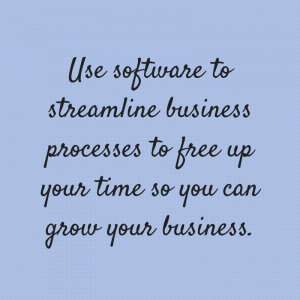The truth is that your bookkeeping is a nightmare because you ignore it until the last possible moment.
The fact is that your accounting software should be chosen, set-up, and used on a daily basis to provide awesome service to your clients. Done correctly, your bookkeeping will show you the results of every business decision in the form of net income on your income statement, not to mention avoiding that surprise tax bill.
When it comes to choosing accounting software, many businesses do little, if any, homework before jumping in and buying software. After all, you only need accounting software so you can crunch numbers for a tax return, right? Absolutely not. Accounting software is the foundation of your business. It helps you serve your customers better and shows you the results of every business decision you make.
Is there a perfect accounting software that I recommend every business use? No. I don’t believe in one size fits all solutions for any part of a business.
The primary accounting software companies in the small business sandbox are Xero and Quickbooks. (Full disclosure: I’m a partner with both.) If you bought Quickbooks without a second thought, you can thank Quickbooks’ marketing efforts for that. Quickbooks has something like 80% of the small business accounting software market in the United States. Does that mean it’s the best solution for your business? Not necessarily.
Choosing and set-up your accounting software for your ideal client is how you simplify your bookkeeping.
What you are selling, to whom, and how you sell determines whether you just created a bookkeeping nightmare.
Products
If you have physical inventory to keep track of, Quickbooks Online has those features. However, if you are selling inventory on multiple channels, Quickbooks can’t handle that and you could find yourself overselling products. Xero has very basic inventory management.
If you are selling physical products on multiple channels (Amazon, E-bay, Etsy, etc.), you’ll need a third-party add-on to accurately keep track of your inventory. If you sell your product in person and online, you need a third-party add-on app with point-of-sale and multi-channel inventory features.Both Quickbooks Online and Xero integrate with numerous inventory add-on apps. The software you use must integrate with your accounting solution otherwise you just created a time-consuming bookkeeping nightmare.
Businesses that sell physical products tend to have more complicated bookkeeping because of the inventory management and sales tax requirements. However, there’s plenty you can do to keep your bookkeeping from looking like something from a horror novel.
If you are selling physical products, especially on multiple channels, I strongly recommend taking a look at TaxJar to help manage your sales tax.
Services
If you are selling services and digital products, how you sell is determined by your ideal client. If your ideal client is large corporations, you need flexible invoicing to accommodate their requirements or payment will be delayed.
Quickbooks Online only offers their merchant service for online payments. Personally, I wouldn’t use it because of the horror stories. When they still owned Intuit Payment Network, Intuit mysteriously held a payment for almost two weeks and refused to provide any explanation. I stopped using Intuit payment services that very day and haven’t looked back.
Xero connects to various payment services such as PayPal, Stripe, and Authorize.net. While automatic recurring payments are not possible in Xero, your invoices can be set-up as recurring and all are sent with a “pay now” button. Invoices in Xero are very customizable and you can have several templates for different needs. Quickbooks Online allows only one invoice template.
Quickbooks Online and Xero both have the ability to create a simple estimate. Both allow you to set up numerous invoice items to use as standard text. If you need more complex, professional-looking proposals with cover pages, images, etc., you’ll want to look at add-on proposal apps such as Quotient. Be sure to choose an app that integrates with your accounting software of choice. Why? Because when the client accepts the proposal the app can automatically push that proposal to your accounting software and create an invoice.
This is just the start to comparing Xero and Quickbooks. The bottom line is that you should choose the accounting software that will do the best job of supporting how you will do business with your ideal client.
Would you like help with your software? Get in touch.







